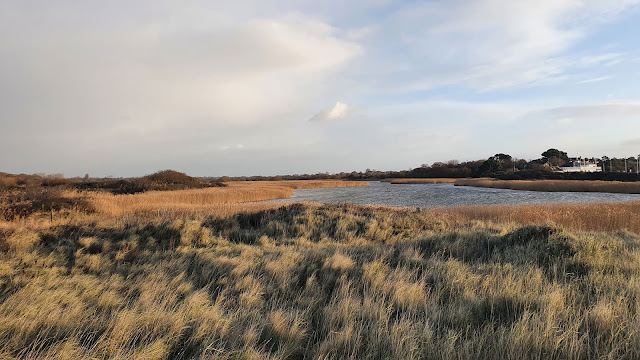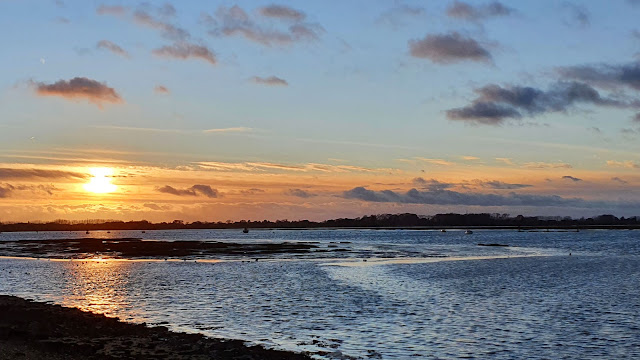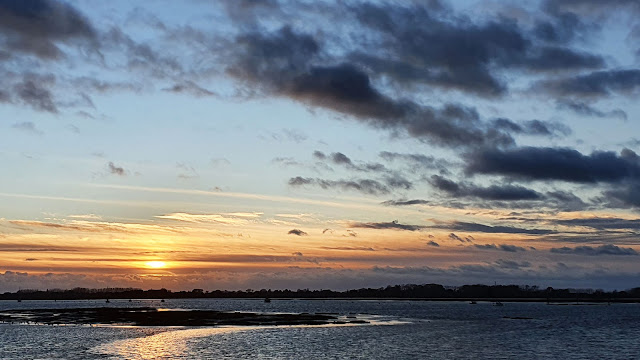With very dreary and damp weather over the Christmas holidays it was pleasing to see a better forecast on the Tuesday, an opportunity to get out for some birding and fresh air. As I left home the skies were clear and there was the threat of the sun appearing, but about ten minutes into the journey there was rain and I passed through showers all the way to Hill Head.
Pulling up at the sea wall Ian was already there, the tide was falling, but the sea was full of white horses as the very strong westerly whipped up the waves. A way to the west there were very dark clouds and every so often rainbows could be seen over the reserve. A check of the forecast and radar confirmed our thoughts, heavy rain was coming, but maybe it would miss us, we had to wait and see. The reserve was closed so there was no hide option.
We stuck it out watching a male and female Marsh Harrier over the reed bed on the reserve fighting with the wind and putting up all the wildfowl and waders on the scrapes. It was quite clear that north of us was probably getting very wet. Here the clouds moving in from the west.
Here now continuing to move east, but north of us.
The wind was very strong and it made it very difficult to see anything on the water, so, as the weather seemed to be on our side, we headed up on to Brownwich Cliffs to get some elevation and the chance to watch the sea a little better.
While there wasn't a great deal moving, we quickly managed to find the six Velvet Scoter that have been present for a good few days. They were grouped together in association with Eider. Every so often they would confirm their identification by vigourously flapping their wings to show the white panels.
A huge flock of well over 500 Brent Geese were out on the water in front of Chilling Cliffs, and as if they all knew the time was right they all took off and headed for the fields, their numbers swelled by other geese coming in from the east.
Ian then found a Slavonian Grebe, again very distant and I picked up on the second one, both birds being close to the Darling Buoy. A check of the field behind us produced large numbers of Pied Wagtail spread out across all of the field. Estimates of well over a hundred. A female Marsh Harrier passed by heading towards Chilling.
With time running out on the car parking we headed back down to have lunch and then move on. We had planned to re-visit Thorney Island once again, the pull of the Short-eared Owls strong again. The wind though might be a problem but we were hoping it would ease as we came to sunset.
The journey was in rain, but this cleared as we arrived and their were signs it was going to be a sunny afternoon if a little windy.
We decided to try the east side, looking west across the fields towards the sea wall. The water in the Deeps was high and there was a flock of Avocet just visible.
Last time we had watched the owls come close to this side of the field.
However today the wind was strong and it looked a little easier in the lee of the sea wall, so after some debate we decided to walk to the sea wall. The breeze was strong, but not as strong as it was during our first visit at the start of the month.
The tide was rising and Dunlin and Redshank were feeding on the mud.
We found a dryish patch of grass and settled down to sit it out and weight, the sun was sinking and there was that incredible golden light, enhanced by the dark and threatening skies away to the east.
We watched a distant Marsh Harrier terrorise the Teal, sending them up into the air and circling around. Brent Geese flew from the harbour across towards the fields on the east side.
I kept my eye in and checking exposure by photographing the Black-headed Gulls flying overhead.
But as time slipped by we were left with just this view of where the Short-eared Owls were meant to be.
With the sun slipping away and still no appearance of the owls we turned to entertaining in other ways, here the grass of the sea wall silhouetting against the golden sky of the setting sun.
The yachts in Chichester Harbour righted by the rising tide.
A beautiful sunset as the sun sinks below Hayling Island.
The view that the houses that line the sea front in Emsworth see every day..
It was clear the owls were not coming out. the sun was now set so we made our way back along the sea wall. As we reached the turn a Kestrel appeared using the wind to hunt the slope of the, lots of photos taken of the same pose, but with a grainy image due to the very high ISO.
So that was the last trip of the year, a disappointing day in not seeing the owls, but nice to be able to get the final year tick of the year in the Velvet Scoter. It was just not a day for photography.















No comments:
Post a Comment